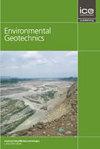Veined Rock Performance under Uniaxial and Triaxial Compression Using Calibrated Finite Element Numerical Models
IF 2.2
4区 工程技术
Q3 ENGINEERING, GEOLOGICAL
引用次数: 0
Abstract
Geotechnical rockmass characterization is a key task for design of underground and open pit excavations. Hydrothermal veins influence excavation performance by contributing to stress-driven rockmass failure. This study investigates the effects of vein orientation and thickness on stiffness and peak strength of laboratory scale specimens under uniaxial and triaxial compression using finite element numerical experiments of sulfide veined mafic igneous complex (CMET) rocks from El Teniente mine, Chile. The initial numerical models are calibrated to and validated against physical laboratory test data using a multi-step calibration procedure, first of the unveined Lac du Bonnet granite to define the model configuration, and second of unveined and veined CMET. Once calibrated, the numerical experiment involves varying the vein geometry in the veined CMET models by orientation (5 to 85°) and thickness (1, 4, 8 mm). This approach enables systematic investigation of any vein geometry without limitations of physical specimen availability or complexity of physical materials. This methodology greatly improves the value of physical laboratory test data with a limited scope of vein characteristics by using calibrated numerical models to investigate the effects of any other vein geometry. In this study, vein orientation and thickness were both found to have a significant impact on the specimen stiffness and peak strength.基于校正有限元数值模型的单轴和三轴压缩下脉状岩石的性能
岩土岩体特征是地下和露天开挖设计的关键任务。热液脉通过引起应力驱动的岩体破坏而影响开挖性能。通过对智利El Teniente矿硫化物脉状基性火成岩杂岩(CMET)的有限元数值实验,研究了脉状方向和厚度对实验室尺度试样在单轴和三轴压缩下刚度和峰值强度的影响。初始数值模型使用多步骤校准程序,根据物理实验室测试数据进行校准和验证,首先对未抛光的Lac du Bonnet花岗岩进行校准,以定义模型配置,然后对未抛光和脉状CMET进行校准。一旦校准,数值实验涉及改变脉状CMET模型中的脉状几何形状,通过方向(5至85°)和厚度(1,4,8 mm)。这种方法可以系统地研究任何静脉几何形状,而不受物理标本可用性或物理材料复杂性的限制。该方法通过使用校准的数值模型来研究任何其他静脉几何形状的影响,极大地提高了物理实验室测试数据的价值,这些数据具有有限的静脉特征范围。在本研究中,我们发现静脉的方向和厚度对试件刚度和峰值强度都有显著的影响。
本文章由计算机程序翻译,如有差异,请以英文原文为准。
求助全文
约1分钟内获得全文
求助全文
来源期刊

Environmental geotechnics
Environmental Science-Water Science and Technology
CiteScore
6.20
自引率
18.20%
发文量
53
期刊介绍:
In 21st century living, engineers and researchers need to deal with growing problems related to climate change, oil and water storage, handling, storage and disposal of toxic and hazardous wastes, remediation of contaminated sites, sustainable development and energy derived from the ground.
Environmental Geotechnics aims to disseminate knowledge and provides a fresh perspective regarding the basic concepts, theory, techniques and field applicability of innovative testing and analysis methodologies and engineering practices in geoenvironmental engineering.
The journal''s Editor in Chief is a Member of the Committee on Publication Ethics.
All relevant papers are carefully considered, vetted by a distinguished team of international experts and rapidly published. Full research papers, short communications and comprehensive review articles are published under the following broad subject categories:
geochemistry and geohydrology,
soil and rock physics, biological processes in soil, soil-atmosphere interaction,
electrical, electromagnetic and thermal characteristics of porous media,
waste management, utilization of wastes, multiphase science, landslide wasting,
soil and water conservation,
sensor development and applications,
the impact of climatic changes on geoenvironmental, geothermal/ground-source energy, carbon sequestration, oil and gas extraction techniques,
uncertainty, reliability and risk, monitoring and forensic geotechnics.
 求助内容:
求助内容: 应助结果提醒方式:
应助结果提醒方式:


